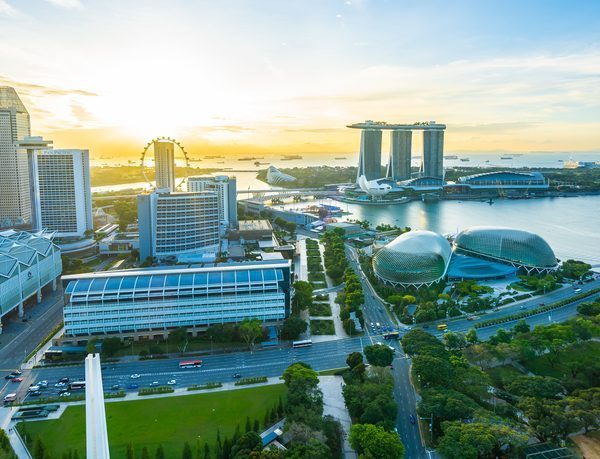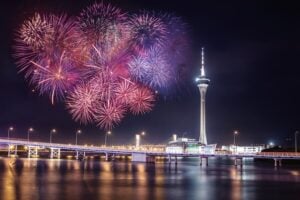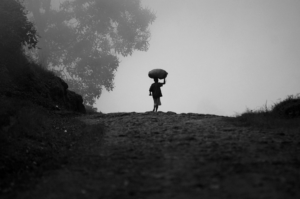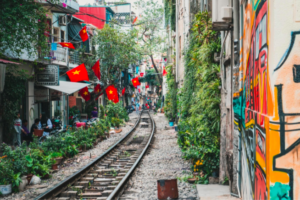Uncovering Singapore’s past, present, and future
Despite being a quick two-hour flight from Ho Chi Minh City, Singapore and Saigon could not be more different. With gorgeous green spaces, spotlessly clean streets, a multi-cultural population harmoniously co-existing, and a modern, breezy lifestyle—Singapore is often held up as a model for Southeast Asia and beyond. Walking, eating, and Instagramming our way through Singapore, our mission was to uncover how this tiny, spacestarved, resource-poor state become a regional powerhouse and modern playground.
Separate but Equal
Blessed with a strategically-located, natural harbor at the mouth of the Strait of Malacca, Singapore was established as a British free port in the early 1800s as a means to “destroy the spell of Dutch monopoly”. In addition to merchants from Armenia, Arabia, Europe and beyond, laborers from China and British India arrived to help clear the land, transport materials, and build the town, quickly swelling Singapore’s population to more than 10,000 within five years of the port’s opening. Doing much of the hard work, each of these communities settled in ethnically segregated residential zones.
“This dish reminds me of Singapore’s melting pot of cultures,” says PS of Everyday Tour Company as we tuck into a tangy sweet “salad” known as rojak. “The potatoes represent the British, the tofu the Chinese, and the fermented shrimp fritters from Malaysia. All different ingredients that blend together for a yummy dish.” Meaning “eclectic mix” in colloquial Malay, this Indian version of rojak seems to sum up Singapore’s unique blend of cultures.
Outside, in the area known as Little India, we walk by a brightly colored mural by local visual artist Eunice Lim depicting whimsical patterned cows. “This area was near the water and was used to raise cattle,” explains PS along her street art and street food tour. While Little India was originally a playground for the Europeans, evidenced by an open space that used to be a race course, its ponds, mangrove swamps and proximity to the Serangoon River made it good for raising cattle which were not only used for meat and milk but to pull bullock carts, the island’s main means of transportation. Indian settlers took to the cattle trade and Little India was born.
After a quick metro ride to Chinatown, we soon find ourselves stuffing our faces with popiah, a fresh spring roll stuffed with lettuce, egg, turnips, and fried flour bits, all wrapped in a handmade skin from the Michelin Plate-awarded Ann Chin. Originating in China’s Fujian province, it’s just one of the many dishes Chinese immigrants brought with them to Singapore. Mainly farmers and fishermen, immigrants took advantage of Singapore’s free immigration policy which made it easier for poorer immigrants to come, either as free or indentured laborers. “That’s why letter writers were so important back then. You could say they were the Instagrammers of their time,” says PS, as we take in a mural depicting an older man writing letters for uneducated and illiterate immigrants. “They were the social bridge, writing letters to family back in China and then reading the replies. They knew all your secrets, so it was best not to piss them off,” laughs PS.

Letter writer
Local Born
When Chinese and Indian men arrived on the Malay Archipelago, they often took wives among the local Malay or Indonesian women. Their children were known as Peranakan or “local born”. To find out more about this unique community, we head to the tony district of Joo Chiat, known for its pretty pre-war homes with their intricate facades and gorgeous Black and White houses, named for their dark timber beams and whitewashed walls with Tudorbethan flair.
Over sips of ginger “pulled tea”, a strong black tea sweetened with condensed milk made frothy by dramatically pouring it from a height, Kathy of Singabites tells us more of this area named after a wealthy ethnic Chinese businessman of Peranakan descent. “The rich Peranakans settled in this area,” she says of the “local born” who were mainly traders for the Chinese and colonial populations. “You’ll see there are no government flats here. Instead, you have these lovely shophouses with Five Foot Ways,” quaint covered verandas mandated by early urban planning.

Pulling tea
“While the husbands provided the family’s religion, the rest of the influences came from the wives,” explains Kathy as we later nosh on rainbow lapis, a delicate Peranakan (or “nyonya”, meaning “women”) dessert of cold rice pudding flavored with coconut and pandan leaves. Starting to gain popularity outside of Singapore, nyonya cuisine is a signature blend of Chinese cooking techniques along with spices and flavors typically found in Malay and Indonesian food.
Probably the most famous example is katong laksa, an addictively spicy soup whose name might have derived from a Sanskrit word meaning “one hundred thousand”, referring to the extensive variety of ingredients used. It’s said that the Peranakan version came about as local wives incorporated chili peppers and coconut milk into Chinese noodle soup. Kathy orders us each a bowl topped with cockles and prawns, and we gleefully slurp down the thick, soul-satisfying broth that’s a wonderful marriage, literally and figuratively, of Peranakan culture.
Living History
Wanting to learn more of Singapore’s unique culture and history, we next head to the spectacular National Museum. While the museum is the nation’s oldest, dating back to 1887, it’s strikingly modern where a futuristic extension of glass and metal complements one of Asia’s most beautiful neo-classical buildings. We enter the Glass Rotunda where a set of watercolor botanical drawings of plants and animals of the Malay Peninsula from the early 1800s are reimagined as three-dimensional animations. Butterflies flit along the walls, stars light up the night sky and deer romp through forest settings, all enhanced by scents created by Swiss fragrance company Givaudan. “Definitely visit the Glass Rotunda”, lists Raihan Hamid of the National Museum of Singapore as one of her top 3 tips. “Also, don’t be afraid to engage with the exhibits where there are often things to touch and do. Thirdly, visit the History Gallery as it charts the development of the island through the years, all in one exhibit.”

Urban greenery at National Museum
We take her up on the tip and head to the History Gallery, focusing on Singapore’s modern reinvention. With a labor-driven economy, no real natural resources, and not much of a domestic market, prospects for the island nation looked dim as it attained self-government in 1959. However, led by Dr Goh Keng Swee, Singapore’s first Minister for Finance, Singapore began welcoming foreign investors and multi-national corporations. The government also invested in technical training with the aim of moving towards building a skills-intensive workforce. We walk through more exhibits showing key developments of the 60s and 70s, including a multi-media display showing the building of government flats which made home ownership highly affordable thereby bringing citizens into the city, and an exhibit outlining the 10-year cleanup of the Singapore River, complete with a funnel to experience what the river used to smell like.
Happy Hill
For a better view of modern-day Singapore, we take the cable car to Mount Faber, the island’s secondhighest hill. Another of Dr Goh Keng Swee’s projects, the 1,750m-long Mount Faber Line has since transported more than 57 million passengers between Mount Faber and the resort island of Sentosa since opening in 1974. At the top, we look out over lush swaths of forest and out to Keppel Harbor, Sentosa Island, and the open ocean beyond. Panoramic views are framed by the large Bell of Happiness and hundreds of smaller bells tied to the fence, complete with handwritten wishes for a life full of happiness, peace and harmony.

Wishing bells on Mt Faber
A Whale of a Time
A key to Singapore’s success has been utilizing its limited assets in innovative ways. Part of that has been a twocentury long project to reclaim land from sand, resulting in a whopping 25 percent of precious real estate added to the tiny island nation. One of the best examples is the resort island of Sentosa, incorporating three nearby islands and islets to its landmass, now known for world-class theme parks, hotels, and residences. We spend an afternoon at the spectacular South East Asia Aquarium (S.E.A. Aquarium) at Resorts World Sentosa. Home to more than 100,000 marine animals representing 1,000 species, it’s one of the world’s largest aquariums. We wander the interactive exhibits featuring more than 50 diverse habitats spanning an incredible 42.8 million litres of water. Engaging for all ages, we gape at sharks swimming overhead in the Shark Seas underwater tunnel, take in the explosion of colors in the 8m-high Coral Garden, and are hypnotized by the rhythmic swimming of a thousand jelly fish all lit up in an array of colored lighting. But it’s the Open Ocean Habitat that has us truly slack jawed. At 36m long and 8.3m high, it’s a glorious 70cm-thick acrylic window (equivalent to two rows of three double-decker buses stacked atop one another) into the immensity and diversity of the ocean with over 40,000 marine animals including graceful rays and goliath groupers. It’s hard not to feel humbled in front of this vast spectacle that represents just a tiny fraction of our wonderful oceans.

Shipwreck Habitat
Green Fish, Yellow Pot
Brimming with friendly feelings towards the environment but also strangely hungering for seafood, we next make for Yellow Pot, the authentic, innovative Chinese fine dining restaurant at Six Senses Duxton. Beautifully designed by acclaimed British designer Anouska Hempel, the boutique hotel transforms a row of 1920s heritage trading houses into the brand’s only city property anywhere in the world. Dark woods and an elegant black and gold palette create an intimate aura, but it’s the modern Chinese cuisine featuring quality, sustainability-certified ingredients with no addition of MSG that brings us here. Six Senses is committed to sourcing locally before internationally, and the tea we drink comes from a tea house just a few blocks over while the Kühlbarra Barramundi (USD24), beautifully steamed and topped with a healthy yet kicky scallion-ginger pesto, is farmed just 40 minutes away. The Wokseared Organic Grass-fed Beef Tenderloin (USD28) is melt-in-your-mouth tender, with hints of sweetness and heat provided by a thick glaze of honey and two types of peppercorns. However, for any halfway decent Chinese restaurant, the yardstick has to be its Roast Duck (USD27). Here, Yellow Pot’s version is outstanding, true to the original Beijing style but with some new twists. The duck is marinated in a mixture of dried spices and fermented bean curd for days, then roasted over hickory wood chips for that dish-defining crispy skin and juicy meat pairing. If this is the future of Chinese cuisine, it’s a sunny prospect indeed.
City in a Garden
Not content to simply be a “Garden City”, Singapore is aiming to be a “City in a Garden” where greenery and flora aren’t just decorative accents, but play a part in actually impacting the quality of life. Stepping foot onto Singapore, it’s hard not to notice all the trees and plants shading the entire road from the airport into the city with medians bursting with flowers. Within the city, every conceivable space seems to be filled with greenery, a natural way to break up the concrete and glass.
Leading this transition is the stunning Gardens by the Bay, a ginormous 101ha waterfront park instantly recognizable by its 18 spaceage Supertrees that stand from 25-50m tall, some of them doubling as air exhaust structures while others harvest solar energy. We wander around the gardens entranced, taking in the magical Floral Fantasy exhibit and walk through the horticulturalthemed gardens. But it’s really the two Cooled Conservatories, entire climates recreated within futuristic domes, that are most impressive. The Flower Dome replicates the cool-dry climate of the Mediterranean with lots of blooming flowers and shrubbery, while the Cloud Forest is in a class all of its own. Walking in, you’re confronted with a 35m-tall mountain shrouded in lush vegetation and mist fed by the world’s tallest indoor waterfall. Behind every exhibit of the museum, there’s an element of edutainment – educating visitors while providing interesting and at times thought-provoking commentary on our fragile environment—including one of the best films I’ve ever seen on climate change, visually showing how each fraction of a rise in temperature will likely affect the earth and its residents.

Cloud Forest
Live, Eat, and Play at Marina Bay Sands
Singapore has a reputation of being a world-class city in which to live, eat, and play and nowhere is this more evident than the incredible Marina Bay Sands complex, just next to the Gardens by the Bay. Recognizable by its triple hotel towers which support a cantilevered Sky Park, 1.2 hectares of gardens and swimming pool 57 stories above the city, the complex is also home to two theatres, a casino, shops and restaurants, all rebuilt on reclaimed land. We’re here to eat and play, and find ourselves at The Shoppes at Marina Bay Sands at lunchtime browsing the star-studded collection of celebrity chef restaurants with household names including Gordon Ramsay, Wolfgang Puck, and Daniel Bouloud. We settle on db Bistro & Oyster Bar by Michelin-starred Chef Daniel Bouloud for its promise of fresh seasonal catch from around the world, prepared using Chef Bouloud’s signature combination of classic French techniques paired with gorgeous presentation. We find that the staff speak Oyster, regaling us with exactly where in the world the day’s oysters are from and their distinct flavor profiles. Finding it impossible to decide, we order the Petit Signature Seafood Platter (USD92) with a chef ’s selection of fresh oysters, Maine lobster, jumbo prawns, mussels, clams, and ceviche, a wonderfully light, refreshing antidote to the hot Singaporean afternoon. The casual bistro atmosphere created by hanging globe lights, red leather banquettes and tasteful nautical accents sets the mood for Chef Bouloud’s casual French fare, like the Pâté “en Croûte”, a work of art incorporating chicken, duck, foie gras, black truffle, smoked bacon, and dashes of brandy and port wine, instantly whisking us to a lavender-filled French country kitchen. For non-seafood fans, there’s the Herb Roasted Chicken Breast, bone-in for extra juiciness, served atop a bed of quinoa with a tomato confit for an explosion of healthy color and flavor.

Oyster bar at db Bistro
From art on a plate to where art meets science, we head across the courtyard to the ArtScience Museum, a dazzling display of the creative processes at the heart of art, science, technology and culture. We enter the interactive exhibits where the line between humans and technology blurs, starting with Future World, the museum’s landmark permanent exhibition. A digital waterfall cascades down the walls and onto the floor, detecting and flowing around visitors. Butterflies flit about, more appearing the more people are in the room, but then dying as they’re touched, a statement about our potential for destruction. Visitors can literally insert themselves into several of the displays by scanning their faces or drawings which immediately become an animated part of the display. While all the galleries practically beg to be Instagrammed, the final one is especially stunning, made up of over 170,000 LED lights resembling twinkling stars that feels like you’re witnessing the birth of the universe. Next, we head into ArtScience Museum’s new exhibition, Wonderland, bringing the enchanted world of Alice in Wonderland to the 21st century and beyond. We unleash our inner Alice-like curiosity, opening cabinets and drawers to discover surprises hidden inside and attend a magical Mad Tea Party where the walls and table settings come alive with projection mapping and other visual effects techniques.

Future World
An Illusion of Flavors
From illusions of sight, we transition to illusions of flavors at Smoke & Mirrors, a chic destination bar perched on the rooftop of the National Gallery Singapore. As its name implies, Smoke & Mirrors is all about applying experimental new twists to turn classic drinks on their heads. Head Bartender extraordinaire Jorge Conde presides over his own backroom workshop where the alcoholic alchemy happens, employing techniques such as fermentation, distillation and preservation to reduce ingredients down to their very essences, often bereft of color. This makes unraveling the unique flavor combinations a surprisingly difficult yet delicious task, even for cocktail aficionados. We try the Between the F1 with its spirit-forward, sour notes inspired by the flavors of Between the Sheets and a Sidecar. Here, though, the twist is in the color, jet black (thanks to a very fine bamboo charcoal powder), a nod to Singapore’s Formula 1 Championship which takes place at the Marina Bay Street Circuit, part of the gorgeous waterfront views commanded by Smoke & Mirrors. In fact, the spirit of Singapore subtly inspires many of the drinks, including the refreshing Robbery at the Museum, a light take on the classic Singapore Sling, adding welcome variations of sour cherry including Maraschino liqueur, cherry brandy and house-made cherry bitters. The drink with the best story of the night, though, is the humorously-named She Uses Cilantro for Everything, with its use of pechuga (Mexican mezcal redistilled with a raw chicken hung over it, supposedly adding to the spirit’s final flavor), cilantro, and chili oil, recalling Singapore’s national dish of chicken and rice.

She Uses Cilantro For Everything
Image by Smoke & Mirrors
Throughout our time in Singapore, we saw this theme repeated again and again, a reinterpreting of the old into something new, even futuristic. Beautifully preserved or repurposed colonial-era shophouses stand next to modern skyscrapers. Land, reclaimed from the sea, to house stylish resorts and world-class entertainment venues. Food and drink that embrace their unique culinary roots while experimenting with new ingredients. The locals have a saying that if you don’t like what you see in Singapore, come back in a year, because it’ll all be different still. Well, we came, we saw, we liked, and we can’t wait to do it all again next year.
Images by James Pham

IF YOU GO…
Everyday Tour Company (www.everydaytourcompany.com) specializes in alternative, non-touristy walks. Signature tours take guests through public housing estates, an evening walk through eclectic Kampong Glam, and a morning walk exploring street art and street food (USD 60). PS kept the pace of the tour lively and struck a lovely balance between sitting and eating and walking to admire street art and the stories behind them.
Singabites (www.singabites.com) is all about unique food-based tours, combining visits to locally-owned eateries with fascinating insights into local stories and cultures. In addition to exploring the neighborhoods of Katong and Joo Chiat, the recently launched Artisan Experience has guests interacting with chefs and hawkers and trying their hand at pouring pulled tea, wrapping rice dumplings and flipping pratas. Oi readers get 15% off Katong morning and evening tours by using code “oivietnam19”.
Admission to the National Museum (www.nationalmuseum.sg) is USD11 and free guided tours are available. Look for the “Wings of a Rich Manoeuvre”, a chorus of eight kinetic chandeliers studded with Swarovski crystals above the bridge linking the National Museum’s original 19th-century colonial building with its modern wing, and lose yourself in the spectacular Story of the Forest in the Glass Rotunda.
Visitors can purchase tickets for either of Singapore Cable Car’s two lines (Mount Faber and Sentosa), or a Sky Pass which allows travel along both lines. See the website (www.onefabergroup.com) for lots of exciting activities, events and promotions in 2019 to mark the Singapore Cable Car’s 45th anniversary, including “Miraculous”, a multimedia night show complimentary for all cable car riders.
One-day tickets to the S.E.A. Aquarium (www.rwsentosa.com) for adults / children are USD30 / 21. The aquarium is part of Resorts World Sentosa where themed attractions, hotels, dining establishments and MICE events no longer serve single-use plastic bottles. If visiting in October, don’t miss the inaugural Wine Pinnacle Awards 2019, a three-day celebration of excellence and diversity in the world of wines (www.winepinnacle.com).
Yellow Pot at Six Senses Duxton (www.sixsenses.com/hotels/duxton/dining) is committed to local, seasonal and responsible sourcing of produce with an emphasis on drawing flavors through fresh and natural ingredients. After your meal, walk the few blocks over to the new Six Senses Maxwell and have a drink at the gorgeous librarythemed bar, Cook & Tras.
Visit both Cooled Conservatories at Gardens by the Bay (www.gardensbythebay.com.sg) for USD 21 / 11 (adult / child), and the Floral Fantasy for USD 15 / 9 (adult / child). Admission to Bay South Garden including the Supertrees and horticultural-themed gardens is free. Just opposite Sands Theatre, at the Galleria Level of The Shoppes at Marina Bay Sands (www.marinabaysands.com), db Bistro & Oyster Bar by Chef Daniel Bouloud is open for lunch and dinner, and brunch on weekends. The Express Lunch is especially popular with the business crowd, an excellent value at USD24 for 2 courses and USD31 for 3.
Timed-admission tickets for 1, 2, or all 3 exhibitions at ArtScience Museum start at USD14. Summer months and weekends are especially high traffic so pre-booking tickets online is strongly recommended at www.marinabaysands.com.
Smoke & Mirrors (www.smokeandmirrors.com.sg) is known for its spectacular panoramic views of Singapore’s skyline and creative cocktail program. If you can’t stand not knowing exactly what’s in your drink and how it was made, simply scan the QR codes for top cocktails on the menu. Cocktails priced from USD16-21.






